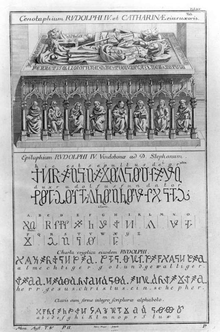Cenotaph for Duke Rudolf IV.
The cenotaph for Duke Rudolf IV. Is a work from the Middle Ages that is in the St. Stephen's Cathedral in Vienna . The cenotaph is empty, however, Rudolf IV (also called the founder ) and his wife Katharina von Luxemburg are not here, but buried in the underground ducal crypt.
history
When Rudolf IV died in Milan on July 27, 1365 at the age of 26 , his body was first treated with red wine for preservation purposes and sewn into a black cow hide, covered with a precious shroud and then transported across the Alps to Vienna, where it was was buried in a copper coffin in the ducal crypt of St. Stephen's Cathedral.
The cenotaph erected for him in St. Stephen's Cathedral and probably already installed during Rudolf's lifetime was originally in the middle of the Albertine choir in front of the high altar, right near the entrance to the duke's crypt. When Emperor Friedrich III. Died in 1493, the cenotaph was moved to the south side of the north choir.
On April 7, 1933, the cenotaph was opened and a finely woven shroud was found inside. It is now in the Cathedral and Diocesan Museum. After the Second World War, it was moved again to the south side of the polygon of the women's choir, where it is still located today. The portrait of Rudolf IV hung in the central choir until the 17th century. When the interior was changed to Baroque style in the 17th century, the portrait was probably first brought to the Heiltumstuhl . Today this portrait is in the Cathedral and Diocesan Museum .
description
The figures are carved from fine-grain Auer sand-lime stone, the Tumba cover from red Adnet marble . Rudolf IV. And his wife Katharina to the left are depicted on the tumba cover, both figures are more than two meters tall. Both are dressed in festive robes, their heads resting on pillows. Her eyes are not closed, at her feet are two lions as a symbol of the resurrection. This type of representation, how the figures lie, is not intended to symbolize death, but rather their resurrection at the Last Judgment.
The base is decorated with Gothic arches, under which there were originally small statues of mourning monks and representatives of the university. There were at least eight statues on each long side. These have been lost over time.
The inscription on Rudolf's grave slab is puzzling. The inscription is encoded in the Alphabetum Kaldeorum , a secret script that was used in the Middle Ages and is believed to be Rudolf IV personally. The inscription only gives the name and title of the duke - it should possibly symbolize Rudolf's preference for the use of secret writing.
See also
- Tomb of Emperor Friedrich III. , also in Vienna's St. Stephen's Cathedral
literature
- Rudolf Bachleitner, Peter Kodera: The Vienna Cathedral . Dom-Verlag, Vienna 1966 36 f.
- Felix Czeike : Historical Lexicon Vienna . Volume 5. Verlag Kremayr & Scheriau, Vienna 1997, ISBN 3-218-00547-7 , pp. 335ff.
- Rupert Feuchtmüller, Franz Hubmann: The unknown cathedral . Herder, Vienna 1984.
Web links
- The Rudolfskenotaph. (No longer available online.) "Our St. Stephen's Cathedral" - Association for the preservation of St. Stephen's Cathedral, formerly the original ; Retrieved September 12, 2009 . ( Page no longer available , search in web archives )
Individual evidence
- ↑ The repeatedly read statement that the corpse of Rudolf IV was supposedly cooked in red wine is probably due to a confusion between the preservation method using red wine and the method of " mos teutonicus ", the use of which was forbidden by Pope Boniface VIII as early as 1299 had been.
- ↑ Annemarie Fenzl: 5th Catechesis 2004/05: Paths to prayer - images of grace and donors (see full text online ) writes: “Duke Rudolf IV., The donor died shortly afterwards, on July 27, 1365 in Milan and was, wrapped in a precious shroud and a black cowhide, brought across the Alps, to Vienna, to his St. Stephen's Cathedral, where he found his eternal resting place. "
- ↑ Markus Ritter: Art with a message: The gold-silk fabric for the Ilchan Abu Sa'id of Iran (Rudolf IV's grave robe in Vienna) - reconstruction, type, medium of representation. In: Contributions to Islamic Art and Archeology , Vol. 2, Ed. M. Ritter and L. Korn, Wiesbaden: Reichert, 2010, pp. 105–135, has worked out that the precious shroud of Duke Rudolf IV was a precious gold-silk fabric with Arabic inscriptions that was originally in Iran 1319–1335 was made for the ruling Muslim Ilchan Sultan there and is now exhibited in the Cathedral and Diocesan Museum (Vienna) .
- ^ State of the Neidhart tomb, Rudolf and Catherine tomb, St. Stephen's Cathedral. Retrieved September 14, 2009 .
Coordinates: 48 ° 12 ′ 30 ″ N , 16 ° 22 ′ 25 ″ E


